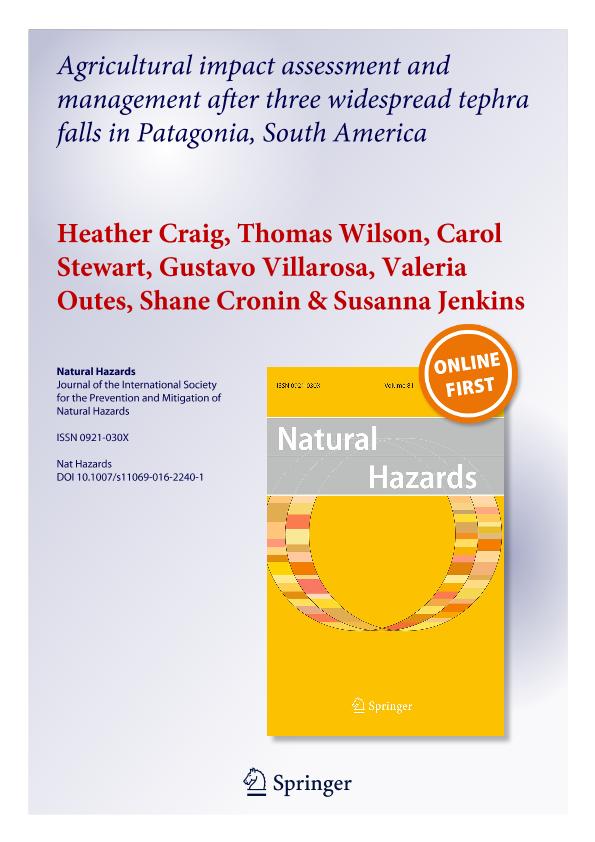Mostrar el registro sencillo del ítem
dc.contributor.author
Craig, Heather
dc.contributor.author
Wilson, Thomas
dc.contributor.author
Stewart, Carol
dc.contributor.author
Villarosa, Gustavo

dc.contributor.author
Outes, Ana Valeria

dc.contributor.author
Cronin, Shane
dc.contributor.author
Jenkins, Susanna
dc.date.available
2018-12-10T15:44:01Z
dc.date.issued
2016-06
dc.identifier.citation
Craig, Heather; Wilson, Thomas; Stewart, Carol; Villarosa, Gustavo; Outes, Ana Valeria; et al.; Agricultural impact assessment and management after three widespread tephra falls in Patagonia, South America; Springer; Natural Hazards; 82; 2; 6-2016; 1167-1229
dc.identifier.issn
0921-030X
dc.identifier.uri
http://hdl.handle.net/11336/66182
dc.description.abstract
Agricultural production is often concentrated in volcanically active or previously active areas where weathered volcanic products form fertile soils. However, this proximity means agriculture is exposed to tephra fall hazards. The type and severity of impacts to agricultural systems from tephra fall are dependent on both the hazard intensity metrics (tephra fall characteristics, such as thickness, grain size) and the vulnerability characteristics of the exposed agricultural system(s). Understanding the relationship between significant intensity metrics of tephra fall hazard and farm-scale and region-scale vulnerabilities is key to impact assessment and informing management and recovery strategies. Several large silicic eruptions have occurred over the past 20 years in the Patagonian region of South America, including the 1991 Hudson, 2008 Chaite´n, and 2011 Cordón Caulle eruptions. These events deposited varying thicknesses of tephra on thousands of farms distributed across a variety of climates and production styles. Drawing on impact assessment data collected from interviews undertaken on post-event impact assessment reconnaissance trips, and other reports, this study evaluates the importance of tephra thickness as a hazard intensity metric, and vulnerability characteristics, when assessing impacts in the short and long term and, compares the effectiveness of response and recovery strategies. Whilst tephra thickness was the best single indicator of agricultural production losses, other factors, notably climate, farm type, and access to mitigation measures such as irrigation and/or cultivation, were also important indicators of damage.The climatic zone and associated precipitation level was found to be one of the most important characteristics of vulnerability, with higher damage occurring at lower tephra thicknesses in the semi-arid regions compared to farms in the temperate zone.
dc.format
application/pdf
dc.language.iso
eng
dc.publisher
Springer

dc.rights
info:eu-repo/semantics/openAccess
dc.rights.uri
https://creativecommons.org/licenses/by-nc-sa/2.5/ar/
dc.subject
Tephra Fall
dc.subject
Tephra Impacts
dc.subject
Impact Assesment
dc.subject
Caulle
dc.subject.classification
Meteorología y Ciencias Atmosféricas

dc.subject.classification
Ciencias de la Tierra y relacionadas con el Medio Ambiente

dc.subject.classification
CIENCIAS NATURALES Y EXACTAS

dc.title
Agricultural impact assessment and management after three widespread tephra falls in Patagonia, South America
dc.type
info:eu-repo/semantics/article
dc.type
info:ar-repo/semantics/artículo
dc.type
info:eu-repo/semantics/publishedVersion
dc.date.updated
2018-11-13T20:35:24Z
dc.journal.volume
82
dc.journal.number
2
dc.journal.pagination
1167-1229
dc.journal.pais
Alemania

dc.journal.ciudad
Berlin
dc.description.fil
Fil: Craig, Heather. University Of Canterbury; Nueva Zelanda
dc.description.fil
Fil: Wilson, Thomas. University Of Canterbury; Nueva Zelanda
dc.description.fil
Fil: Stewart, Carol. Massey University Wellington Campus; Nueva Zelanda
dc.description.fil
Fil: Villarosa, Gustavo. Consejo Nacional de Investigaciones Científicas y Técnicas. Centro Científico Tecnológico Conicet - Patagonia Norte. Instituto de Investigaciones en Biodiversidad y Medioambiente. Universidad Nacional del Comahue. Centro Regional Universidad Bariloche. Instituto de Investigaciones en Biodiversidad y Medioambiente; Argentina
dc.description.fil
Fil: Outes, Ana Valeria. Consejo Nacional de Investigaciones Científicas y Técnicas. Centro Científico Tecnológico Conicet - Patagonia Norte. Instituto de Investigaciones en Biodiversidad y Medioambiente. Universidad Nacional del Comahue. Centro Regional Universidad Bariloche. Instituto de Investigaciones en Biodiversidad y Medioambiente; Argentina
dc.description.fil
Fil: Cronin, Shane. The University of Auckland; Nueva Zelanda
dc.description.fil
Fil: Jenkins, Susanna. University of Bristol; Reino Unido
dc.journal.title
Natural Hazards

dc.relation.alternativeid
info:eu-repo/semantics/altIdentifier/doi/https://dx.doi.org/10.1007/s11069-016-2240-1
dc.relation.alternativeid
info:eu-repo/semantics/altIdentifier/url/https://link.springer.com/article/10.1007/s11069-016-2240-1
Archivos asociados
